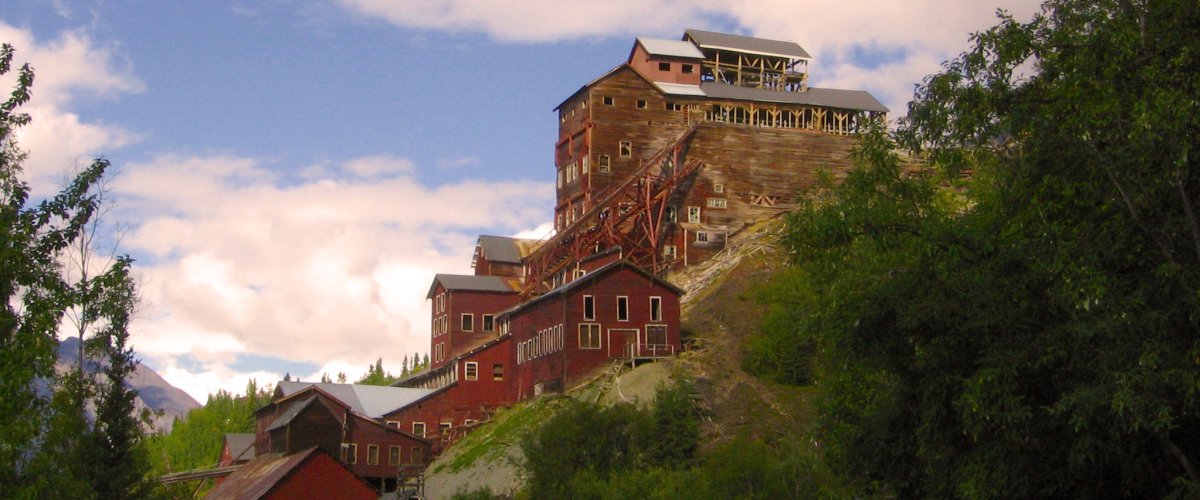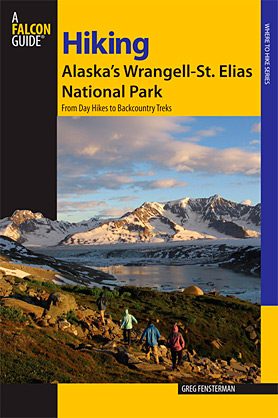
It was the lure of riches in the ground that drew the first pioneers to what is now the McCarthy/Kennicott area in the heart of Alaska's Wrangell St. Elias National Park. But not just gold - it was copper, and lots of it, that put the area on the map. In 1899 gold was discovered near the headwaters of the Nabesna River in what is now the north of the park. It was a good year for mineral exploration in the area because Oscar Rohn also found copper ore samples in the Kennicott glacial moraine that would later lead to the discovery of rich copper deposits on Bonanza Ridge. Production didn't get into full swing until 1911 when a railroad was completed that reached from Kennicott almost 200 miles to Cordova. Ore was transported by rail to Cordova and from there by barge to Tacoma, Washington where it was smelted.
Kennicott was a classic company town. Most of the miners lived there in company housing and everything revolved around the mining operations. McCarthy quickly developed five miles down the road as a support community to the company town. McCarthy provided many services not available in Kennicott including hotels, hospital, shops, school, photographer's studio, brothels and perhaps most importantly of all, saloons.
By 1938 the rich copper deposits were depleted and the mines of Kennicott as well as the railroad, ceased operations. For a while things were pretty quiet though there were always some people living in the area. During the 1970s tourism began to develop in the region and has continued to grow steadily to the present day.
It was the copper strike that gave birth to McCarthy/Kennicott and indeed Wrangell St. Elias National Park itself, and the effects of those origins are felt today. Kennicott is still a company town of sorts, only now the company is the Park Service instead of the Kennicott Mining Company. And Kennicott is still saloon-less. The bordellos are gone, but McCarthy is still the center of social and nightlife in the area - such as it is.
Eventually the railroad was torn up and the rail bed became the foundation of what is now the McCarthy Road. But the road has a way of reminding visitors of its origin as old nails and spikes from the railroad days work their way up to the surface and into the tires of travelers.
Though it would take decades to come to fruition, the first seeds that would lead to the creation of Alaska's Wrangell St. Elias National Park were sown almost as soon as the last train pulled out of Kennicott.
The first person to make a recommendation for protected status for the area, was Ernest Gruening, Director of U.S. Territories when he suggested national park or monument status for the region. After visiting the area in 1938, he wrote a memorandum to the Secretary of the Interior:
The region is superlative in its scenic beauty and measures up fully and beyond the requirements for its establishment as a National Monument and later as a National Park. It is my personal view that from the standpoint of scenic beauty, it is the finest region in Alaska. I have traveled through Switzerland extensively, have flown over the Andes, and am familiar with the Valley of Mexico and with other parts of Alaska. It is my unqualified view that this is the finest scenery that I have ever been privileged to see.
It wasn't until 1978 that the area was designated as a National Monument and 1979 when it was designated as a World Heritage Site. The following year, 1980 President Jimmy Carter designated 13.2 million acres as Wrangell St. Elias National Park and Preserve.
